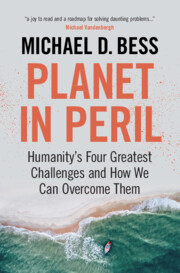Book contents
- Planet in Peril
- Reviews
- Planet in Peril
- Copyright page
- Dedication
- Epigraph
- Contents
- Fictional Vignettes
- Acknowledgements
- 1 Introduction
- Part I Existential Threats: The Four Most Pressing Dangers Facing Humankind
- Part II Strategies and Obstacles: The Solutions We Need, and What’s Preventing Them from Being Realized
- Part III Sensible Steps for Today’s World: Powerful Measures We Can Implement Right Away
- 10 Do It Now: Five Points of Leverage
- 11 Constructive Moves on the International Front for the Next 25 Years
- 12 Breaking the Political Logjam
- 13 Lessons from the Green Movement: How to Build Lasting Change in the Absence of Full Consensus
- Part IV The Middle-Term Goal: New International Tools for the Late Twenty-First Century
- Part V The Long-Term Goal: Envisioning a Mature System of Global Governance for the Twenty-Second Century
- Endnotes
- Bibliography
- Index
10 - Do It Now: Five Points of Leverage
from Part III - Sensible Steps for Today’s World: Powerful Measures We Can Implement Right Away
Published online by Cambridge University Press: 13 October 2022
- Planet in Peril
- Reviews
- Planet in Peril
- Copyright page
- Dedication
- Epigraph
- Contents
- Fictional Vignettes
- Acknowledgements
- 1 Introduction
- Part I Existential Threats: The Four Most Pressing Dangers Facing Humankind
- Part II Strategies and Obstacles: The Solutions We Need, and What’s Preventing Them from Being Realized
- Part III Sensible Steps for Today’s World: Powerful Measures We Can Implement Right Away
- 10 Do It Now: Five Points of Leverage
- 11 Constructive Moves on the International Front for the Next 25 Years
- 12 Breaking the Political Logjam
- 13 Lessons from the Green Movement: How to Build Lasting Change in the Absence of Full Consensus
- Part IV The Middle-Term Goal: New International Tools for the Late Twenty-First Century
- Part V The Long-Term Goal: Envisioning a Mature System of Global Governance for the Twenty-Second Century
- Endnotes
- Bibliography
- Index
Summary
This chapter describes five “action areas” in which politically achievable changes over the coming two decades could render humankind a lot safer than it is today. For climate change, these include urgent measures for rapid decarbonization, coupled with ramped-up research on technologies for carbon removal and for solar radiation management; new international pacts among small groups of nations for emissions reductions with mutual accountability and incentives; and pre-adaptation measures for dealing effectively with unavoidable harms caused by global warming. For nuclear weapons, these include preparing contingency plans for major or limited nuclear wars, as well as risk-reduction measures than can be implemented today. For pandemics, experts point to four sensible and affordable measures that would greatly reduce the harms of future pandemics. For AI, an immediate challenge will be to prepare for chronic mass unemployment due to rising levels of automation. Finally, the chapter proposes the creation of a new federal agency, the Office for Emerging Biotechnology, to oversee and regulate cutting-edge developments in this field.
Keywords
- Type
- Chapter
- Information
- Planet in PerilHumanity's Four Greatest Challenges and How We Can Overcome Them, pp. 133 - 159Publisher: Cambridge University PressPrint publication year: 2022

